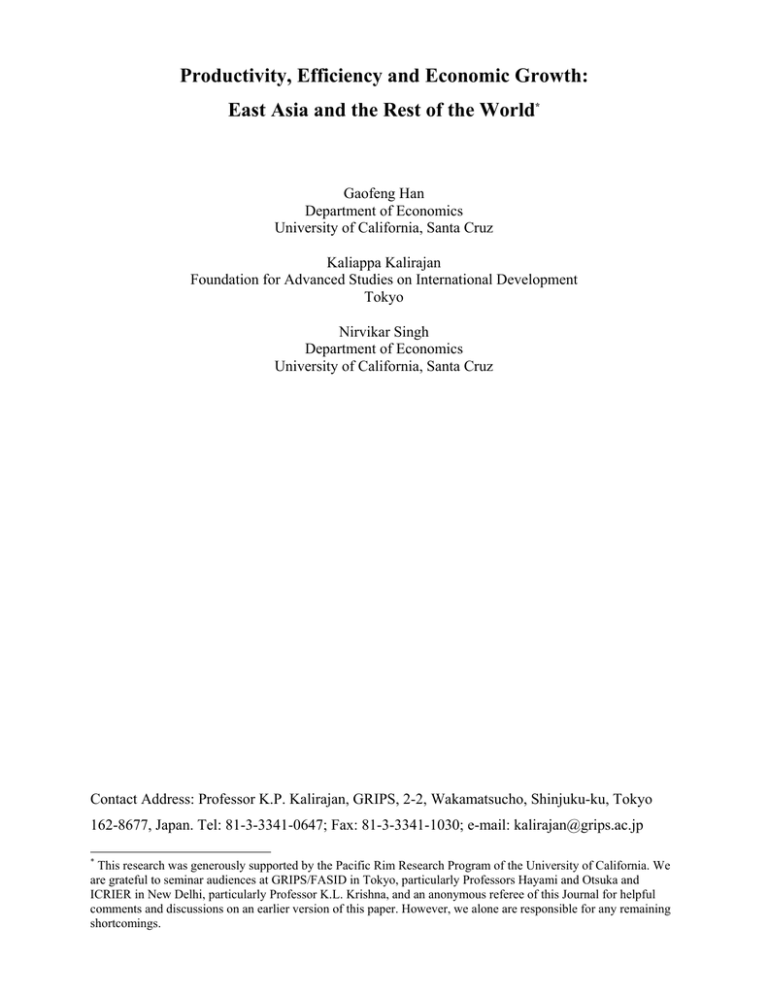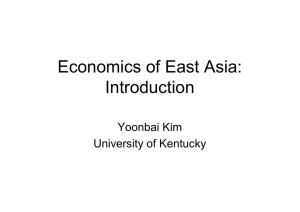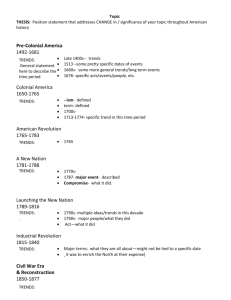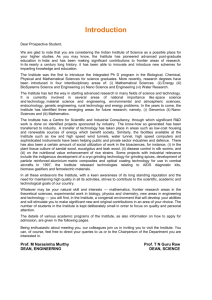Productivity, Efficiency and Economic Growth:
advertisement

Productivity, Efficiency and Economic Growth:
East Asia and the Rest of the World*
Gaofeng Han
Department of Economics
University of California, Santa Cruz
Kaliappa Kalirajan
Foundation for Advanced Studies on International Development
Tokyo
Nirvikar Singh
Department of Economics
University of California, Santa Cruz
Contact Address: Professor K.P. Kalirajan, GRIPS, 2-2, Wakamatsucho, Shinjuku-ku, Tokyo
162-8677, Japan. Tel: 81-3-3341-0647; Fax: 81-3-3341-1030; e-mail: kalirajan@grips.ac.jp
*
This research was generously supported by the Pacific Rim Research Program of the University of California. We
are grateful to seminar audiences at GRIPS/FASID in Tokyo, particularly Professors Hayami and Otsuka and
ICRIER in New Delhi, particularly Professor K.L. Krishna, and an anonymous referee of this Journal for helpful
comments and discussions on an earlier version of this paper. However, we alone are responsible for any remaining
shortcomings.
2
Productivity, Efficiency and Economic Growth:
East Asia and the Rest of the World
Abstract
This study compares the sources of growth in East Asia with the rest of the world, using a
methodology that allows one to decompose total factor productivity (TFP) growth into technical
efficiency changes (catching up) and technological progress. It applies a varying coefficients
frontier production function model to aggregate data for the period 1970-1990, for a sample of
45 developed and developing countries. Our results are consistent with the view that East Asian
economies were not outliers in terms of TFP growth. Of the high-performing East Asian
economies, our methodology identifies South Korea as having the highest TFP growth, followed
by Singapore, Taiwan and Japan. Our methodology also allows us to separately estimate
technical efficiency change, which is a component of TFP growth, and we find that, in general,
the estimated technical efficiency of the high-performing East Asian economies was not out of
line with the rest of the world.
Keywords: Total factor productivity growth, technical efficiency change, technical progress,
sources of growth, varying coefficients frontier production functions.
JEL codes: C21, O30, O47
3
Productivity, Efficiency and Economic Growth: East Asia and the Rest of the World
1. Introduction
Starting from the 1960s several East Asian countries achieved sustained high rates of
growth that were unprecedented. This growth experience not only dramatically changed
people's lives in those countries, but also raised issues such as what had been the contributing
factors, and whether the East Asian experience was replicable. While the East Asian economies,
such as Singapore, South Korea, Taiwan and Japan, are a diverse group, economic analysis
focuses on sources of growth that are quantifiable and have potentially the same impact across
countries. These include the role of factor accumulation and of technological change. While
institutional, cultural and political factors are certainly relevant, and have been addressed by
economists to the extent that they can be quantified (e.g., Barro and Sala-i-Martin, 1995,
Barro,1997), much of the attention has been on the relative roles of increases in the quantities of
the basic economic inputs, namely capital and labor, versus changes in the productivity of those
inputs.
While some assessments of the “sources of growth” literature (e.g., Felipe, 1999) have
questioned this entire approach and its theoretical basis, it remains true that empirical studies
have been both numerous and influential. For example, the World Bank (1993) and Hughes
(1995) examined the contribution of public policy in economic development; Kim and Lau
(1994), Young (1992, 1995) and Krugman (1994) emphasized capital accumulation in the high
performing East Asian economies; Sonobe and Otsuka (2001) advanced a hypothesis that
capital deepening associated with transformation of industrial structure has been the major
factor for sustaining growth for a long period in East Asia; Hayami and Ogasawara (1999)
argued that Japan has continued to depend more heavily on physical capital accumulation
mainly due to its characteristic of borrowed-technology based economic growth; and Singh and
Trieu (1997, 1999) focused more on the role of technological change. Despite many differences
in data and analytical methodologies, these and numerous other studies tended to have one
common assumption in analyzing the relative role of input accumulation and productivity
change: they assumed that production was always on the frontier without any slack in
production.
In this paper, we relax this assumption of full technical efficiency, instead allowing for
the possibility that an economy may be inside the best practice frontier. This approach is
4
justified by the fact that the production process is not simply an engineering relationship
between a set of inputs and observed output, but instead is the result of a series of economic
decisions based on various non-price and organizational factors, which influence the method of
application of inputs. Hence the relevant economic institutions will also play an important part
in an economy’s output. Our approach allows us to calculate total factor productivity growth in
an alternative manner to most previous studies. More importantly, it allows us to distinguish
between changes in technical efficiency (movement towards the frontier) and technological
progress (shifting the frontier) in analyzing the sources of growth in East Asia. Making this
distinction in a cross-country analysis represents the main contribution of the paper.
The structure of the paper is as follows. Section 2 provides a brief literature review,
focusing on papers that are most relevant to our work. The methodology followed in this paper,
as well as the data used, are explained in Section 3. In Section 4, we present the empirical results
for our cross-country analysis. Section 5 provides a summary conclusion.
2. Sources of Growth in East Asia: Previous Studies
The work closest in spirit to ours is that of Young (1994), Fischer (1993), Marti (1996)
and Collins and Bosworth (1997), who all looked at large cross-sections of countries. Young
regressed the output growth rate per worker on a constant and the growth of capital per worker
for the period 1970-1985 using cross-country data constructed from the Penn World Tables. The
capital stock was constructed by the perpetual inventory method with the accumulating
investment flows for 1960-1969 as benchmark, and a 6% depreciation rate. Young’s results from
this exercise were that, while TFP growth in Hong Kong was relatively high, it was not out of the
ordinary in South Korea and Taiwan, and very low in Singapore. Fischer (1993) used the growth
accounting method to estimate three sets of TFP growth rates, each with a different weight for
labor and capital, on data from the Penn World Tables. He obtained a negative TFP growth rate
for Singapore, and fairly low rates of TFP growth for Taiwan. Marti (1996) examined Young’s
(1994) results with slightly fewer countries but more periods than Young’s data set, again using
the Penn World Tables. She obtained a positive TFP contribution to the growth rate for
Singapore, while her results for other East Asian high performers were roughly consistent with
Young’s. Using growth accounting, Collins and Bosworth also found rates of TFP growth for
East Asian high performers that were not extraordinarily high.
Not all detailed growth accounting exercises agree with the results of cross-country
analyses. Looking at Hong Kong, Singapore, South Korea, and Taiwan, Young (1995) argued
5
that East Asia was not very different from Latin America in its TFP changes. However, Singh
and Trieu (1999) showed that this conclusion might be flawed, since it was based on comparing
results from different methodologies. Other growth accounting exercises for individual East
Asian countries have also given mixed results (Felipe, 1999).
The use of a frontier production function approach to analyze TFP growth in East Asia is
more recent than growth accounting estimates. For example, in a wider-ranging study, Han,
Singh and Kalirajan (2001) apply the stochastic production frontier methodology to
manufacturing sector data for Hong Kong, Japan, Singapore and South Korea, performing
analyses across sectors as well as across countries. They demonstrated that this methodology has
facilitated decomposing TFP growth into technical efficiency changes and technological
progress, and found that input growth has been the major contributor to economic growth in the
four economies considered. However, that analysis leaves an unanswered question of how do the
East Asian high performers compare to the rest of the world in terms of sources of growth. This
paper fills this gap by applying the frontier production analysis to a cross-section of countries
that includes most of the East Asian high performers.
3. Methodology and Data
A variety of techniques have been used to measure TFP growth (e.g., Fried, Lovell and
Schmidt 1993). This study applies a recently developed technique, i.e., the varying coefficient
production frontier approach, which isolates catching up to the frontier (technical efficiency
improvement) from shifts in the frontier (technical progress) (Kalirajan, Obwona and Zhao,
1996). This approach assumes that an economy obtains its full technical efficiency by following
best practice techniques, given the technology. In other words, technical efficiency is determined
by the method of application of inputs, regardless of the levels of inputs (that is, scale of
operation). This implies that different methods of applying various inputs will influence the
output differently, and the slope coefficients will vary from economy to economy. This varying
coefficient production frontier approach is an improvement over the conventional constant-slope
production frontier approach to measuring technical efficiency (Aigner et al, 1977; Meeusen et
al, 1977).
For a given technology, it may be interesting to know whether the gap between "best
practice" techniques and realized production methods is diminishing or widening over time.
Changes in technical efficiency can be substantial and may outweigh gains from technical
progress itself. It is, therefore, important to know how far one is off the production (technology)
6
frontier at any point in time, and how quickly one can reach the frontier. For instance, in the case
of economies such as East Asian countries, which borrow technology extensively from abroad,
failure to acquire and adapt the new technology to local production environment will result in not
operating on the production frontier, but below it without realizing the full potential of the
borrowed technology. The movement of the production or technology frontier over time, on the
other hand, reflects the success of explicit policies to facilitate the acquisition of foreign
technology. Similarly, changes in technical efficiency over time and across individual countries
will indicate the level of success of a number of important dimensions of industrial policies.
Technical efficiency and technical progress are examined for a given level of inputs.
The technological change component of productivity growth captures shifts in the
frontier technology and can be interpreted as providing a measure of innovation. This
decomposition of total factor productivity growth into technical efficiency improvement
(catching-up) and technological change is, therefore, useful in distinguishing innovation or
adoption of new technology by "best practice" firms from the diffusion of technology.
Co-existence of a high rate of technological progress and a low rate of change in technical
efficiency may reflect the failures in achieving technological mastery or diffusion.
3.1. The Varying Coefficients Stochastic Frontier model
Assuming a Cobb Douglas production technology, the varying coefficients production
frontier for the tth period can be written as follows:
K
ln Yit = α 1i + ∑ β ki ln X kit
(1)
k =2
i = 1,...,N.
where α 1i = α 1 + u1i ; and Yit is the output level of the ith economy in period t; Xkit is the level of
the kth input used by the ith economy in period t; α 1i is the intercept term for the ith economy;
β ki is the actual response of the output to the method of application of the kth input by the ith
economy; and u ki refers to the random variable term which has mean zero and variance σ ukk .
Let
β ki = β k + u ki ;
where,
E (β ki ) = β k ,
E(u ki ) = 0 and
k = 1,2,...K and i = 1,2,...N
7
Var(u ki ) = σ ujk for j = k and 0 otherwise.
With these assumptions, model (1) can be written as
K
ln Yit = α 1 + ∑ β k ln X kit + wkit
(2)
k =2
where
K
wkit = ∑ u ki ln X kit + u1it
k =2
E (wkit ) = 0 for all i and k.
K
Var (wkit ) = σ u11 + ∑ σ ukk ln 2 X kit
k =2
COV (wkit , w jit ) = 0 for k ≠ j .
Following the estimation procedures suggested by Hildreth and Houck (1968), the mean
response coefficients ( α ’s) and the variances ( σ ukk ) can be estimated and the individual
response coefficients ( β ki ’s) can be obtained as described in Griffiths (1972). Drawing on
Kalirajan and Obwona (1994), the assumptions underlying model (2) are as follows:
(i) Technical efficiency is achieved by adopting the best practice techniques, which
involve the efficient use of inputs. Technical efficiency stems from two sources: (1) the efficient
use of each input which contributes individually to technical efficiency and can be measured by
the magnitudes of the varying slope coefficients, β ki ’s; and (2) any other economy-specific
intrinsic characteristics which are not explicitly included may produce a combined contribution
over and above the individual contributions. This ‘lump sum’ contribution, if any, can be
measured by the varying intercept term.
(ii) The highest magnitude of each response coefficient and the intercept form the
production coefficients of the potential frontier production function. Let ( α ∗ ’s) and ( β ∗ ’s) be
the estimates of the coefficients of the frontier production function, that is,
α k∗ = max i {α ki }; β ∗j = max i {β ji }; k = 1,...K; i = 1,. . .,N and j = 2,...,T.
Now the potential frontier output for individual observations can be calculated as
8
K
ln Yit∗ = α 1∗ + ∑ β k∗ ln X kit ; i = 1,...N
(3)
k =2
where Xkit is the actual level of the kth input used by the ith economy in period t. A measure of
technical efficiency denoted by, say, E, can be defined as
Eit =
Yit
exp ln Yt ∗
(
)
(4)
where the numerator refers to the realized output and the denominator shows the potential
frontier output calculated from (3).
3.2. Decomposition of TFP growth
Figure 1, which is in logarithms, illustrates the decomposition of total output growth into
input growth, technical progress and technical efficiency improvement. In periods 1 and 2, the
economy faces production frontiers F1 and F2 respectively.
If a given economy has been
technically efficient, output would be yl* in period 1 and y2* in period 2. On the other hand, if
the economy is technically inefficient and does not operate on its frontier, then the economy's
realized output is y1 in period 1 and y2 in period 2.
Technical inefficiency is measured by the vertical distance between the frontier output
and the realized output of a given firm, that is, TE1 in period 1 and TE2 in period 2, respectively.
Hence, the change in technical efficiency over time is the difference between TE1 and TE2.
Technological improvement is measured by the distance between frontier F2 and frontier F1, that
is, (y2* - y2**) using x2 input levels or (yl**- yl*) using x1 input levels. Denoting the contribution
of input growth to output growth (between periods 1 and 2) as ∆y x , the total output growth, (y2 yl), can be decomposed into three components: input growth, technological progress and
technical efficiency change. Referring to Figure 1, the decomposition can be shown as follows:
D = y2 - yl
= A+B+C
= [yl* - yl] + [yl**- yl*] + [y2 - yl** ]
= [yl* - yl] + [yl** - yl*] + [y2 - yl** ] + [y2*- y2* ]
= [yl* - yl] + [yl** - yl*] - [y2*- y2] + [y2*- y1** ]
= {[yl* - yl] - [y2*- y2]} + [yl**- yl*] + [y2*- yl** ]
= {TE1 - TE2} + TC + ∆y x
where
y2 - yl = Output growth
(5)
9
TE1 - TE2 = Technical efficiency change
TC = Technical change and
∆y x = Output growth due to input growth.
Solow (1957) attributed output growth to input growth and technical change. The
decomposition in (5) enriches Solow’s dichotomy by attributing observed output growth to
movements along a path on or beneath the production frontier (input growth), movement toward
or away from the production frontier (technical efficiency change), and shifts in the production
frontier (technological progress).
3.3 Data
The data is from the Penn World Tables and the World Bank STARS database. We
choose sample countries based on the data quality ranking by Summers (1992) (see Appendix).
Any economy chosen is at least at the three-star level, which leaves a total of 45 economies in
our sample. Unfortunately, Hong Kong is not in our sample, but other East Asian high
performers are included. The series retrieved from the Penn World tables are capital stock per
worker (1985 international prices), real GDP per capita (1985 international prices), and the series
from STARS are population and labor force. We multiply capital per worker by labor force to
get capital stock, and multiply real GDP per capita by population to get real GDP. The GDP and
capital stock are measured in dollars, and labor force is measured in persons.
4. Empirical Results
Using the methodology described in the previous section, we estimated frontier production
functions for the 45 country sample year by year for 1970, 1975, 1980, 1985, and 1990. Given
the objective of this paper, we used the frontier production function estimates to calculate the
technical efficiency, technical progress and inputs growth for each country by decomposing the
growth rates for 1970-1975, 1975-1980, 1980-1985, and 1985-1990. Detailed results are
presented in the Appendix, while we discuss the overall results in this section. Though we could
not test individual country’s production function because of the sample property, the mean
response coefficients estimates of all countries for the chosen 5 years are tested for individual
years for constant returns to scale. Results based on Wald’s test statistics indicate that the
hypothesis of constant returns to scale could not be rejected for the chosen data set. The results
are given in Appendix Table A1.
10
Table 1 indicates that growth was almost positive in the economies during the periods
analyzed here, and that the estimated contribution of input accumulation to growth was also
almost invariably positive. The TFP growth was positive slightly less than half the time on
average (across all the sub periods). On decomposing the TFP growth, the results show that
estimated technical efficiency changes tended to be positive more often than the other
component.
Table 2 presents more specific results for the four high performing East Asian
economies in our sample: Japan, Singapore, South Korea and Taiwan, as well as averages for
the whole sample and for OECD countries in the sample. Japan’s TFP growth rates are
estimated to be negative or negligible throughout the period. Korea had negative TFP growth in
the first decade, switching to positive in the 1980s. Singapore does not show up too badly in
terms of TFP growth according to this methodology; it had positive TFP growth during 197075 and 1985-90, though its TFP growth was negative during 1975-1985. Finally, Taiwan’s TFP
growth alternates signs between negative and positive during the period of analysis. Overall,
none of the four economies stands out from the others in terms of high TFP growth, and the
patterns over time appear to be quite different. This broad conclusion also holds for the
estimated components of TFP growth, namely, technical efficiency change (TEC) and
technological progress (TP): there is no obvious similarity in patterns over time, and no
economy stands out in terms of levels of performance.
Next we turn to comparisons of the four East Asian economies with the OECD and the
whole sample averages. With the exception of Japan, which is already a matured economy in the
sample period, the other three economies have significantly better growth performances than the
averages in each sub period. However, in almost every case, the difference in growth
performance compared to the averages is largely, or even wholly, accounted for by a higher input
contribution. Thus, in the case of Japan, the result is in conformity with the conclusion of
Hayami and Ogasawara that Japan has continued to depend more heavily on physical capital
accumulation even since Japan’s economy has reached a mature stage and the accumulation of
human-capital-augmented labour, which can be gauged by the technical efficiency
improvements, was not faster than that of physical capital in Japan.
Input contribution of OECD average is also lower than in the four economies. Whether
we compare estimated TFP growth, efficiency changes or technological progress, the East Asian
high performers do not appear to stand out compared to the sample overall, or compared to
OECD countries. Our conclusion based on these estimates would therefore be in line with Alwyn
11
Young’s, though the methodology used is quite different: East Asian growth can be mostly
explained by high rates of input accumulation.
Aside from the issue of TFP growth and its decomposition into efficiency change and
technological progress, another measure of East Asian growth performance is the calculation of
their relative efficiency, and how that changes over time. In Table 3, we present the technical
efficiency (catching up with the production frontier) rankings for each of the five years in our
data. By fitting a production frontier to each year’s data, we are able to estimate where each
country in the sample lies relative to the global production frontier involving sample countries.
Technical efficiency is defined as the ratio of realized output to potential output.
On the whole, the results on efficiency rankings seem reasonable. The bulk of the highefficiency group made up of developed economies such as the United States, United Kingdom
and Canada are high in the rankings, whereas economies typically perceived as inefficient are
much lower down. Of the four high-performing East Asian economies in our sample, only
Taiwan appears high in the efficiency rankings. Japan moves around in the middle of the pack
over this period, while Singapore and Korea are invariably in the lower third and fourth groups
for all the sample years. Thus, the frontier estimations suggest that in general the high
performing East Asian economies did not stand out in terms of levels or improvements in
technical efficiency compared to the rest of the world, even as they were achieving great strides
in development and growth during these years. In other words, during the study period, these
East Asian countries had been producing inside the frontier and slightly shifting the frontier
without realizing fully the frontier with which they were operating.
5. Conclusion
In this paper, we use the varying coefficients stochastic production frontier approach and crosssection data for 45 countries to analyze the sources of economic growth in East Asia and
compare them with the rest of the world, particularly the OECD countries. Our methodology
allows us to decompose the TFP growth into technical efficiency change and technological
progress. Further, this methodology facilitated carrying out additional analysis, which was not
done by Young or other researchers earlier. One such extension of analysis is that of the
efficiency ranking and comparison across the countries. Other methodologies might allow for
TFP ranking, but not the Technical Efficiency ranking. We can do both, though we have
emphasized the latter in our paper.
12
Our findings elaborate on the status of the components of TFP. Technical efficiency
rankings need not necessarily be consistent with TFP rankings. For example, (a) Taiwan has a
much higher rank in terms of technical efficiency, compared to the TFP rank; (b) Industrialized
economies, such as US, UK, Canada, New Zealand, Sweden, Austria, Australia, are well on the
top of the efficiency ranking, while in Young (94), they are at mediocre or low level in terms of
the TFP ranking. The difference of these two rankings indeed gives our methodology some
leverage. For those industrialized countries, even TFP is low at certain period of time, they stand
out by their high technical efficiency, which is one of the important criterions for sustaining a
country’s competitiveness gloablly. Thus, our analysis adds another valuable dimension in
sources of growth analysis.
Our estimation results suggest that during 1970-1990, the four high-performing East
Asian economies in our sample – Japan, Singapore, South Korea and Taiwan – do not stand out
from the rest of the world in terms of their TFP growth performance, or in terms of their
efficiency in input use. Input growth appears to be the main contributor to their overall economic
growth. It may be argued that institutions have been playing important roles in fostering such a
pattern of growth in East Asia. In the context of the labour input, these Asian economies have
large populations and so it is natural that their usage of labor input is large compared to the
Western countries. In the context of capital input, Asian economies have high savings, which is
exactly related to Asian Culture. People work and save much, which is obviously opposite to
Western countries. The high savings finally have to be transformed into high investment.
Besides, Governments in these countries intend to keep high employment, which is also related
to Policy as well as Asian Culture. The culture makes layoff more difficult than in other regions
and also there are no unemployment benefits as in the case of Western countries.
Considering the policy implications, it is clear from Table 3 that East Asian countries
appear to have a lot of catching up to do in technical efficiency improvements. Why Japan,
Korea and Singapore have mediocre or low Tech efficiency? Japanese, Korean and Singaporean
firms are well guided or backed by their governments upon development. They are not as
flexible as US firms with respect to human resources policy and investment policy. Korea’s
Chaebol and Japan’s Harachu are typical institutions (structure) that could lead to high
efficiency as we as low efficiency. The low efficiency emerges if: [a] employees feel that they
have lifetime employment (as in China) and so people would shirk; [2] rigid firm structure could
not response to the varying goods demand outside. Japan and Korea had, and Japan still has,
13
such problem once world demand declined. Over capacity and lack of quick adjustment policy
such as in US could tie down efficiency easily. It is not surprising that most of the firms in these
economies have mediocre technical efficiency. As for Singapore, low technical efficiency might
be from the fact, that there are vast new technical introductions from abroad during the period,
but the human capital did not match the requirements of new technologies in terms of knowledge
and experience. It may be noted that Singapore recently brought many educated employees from
countries like China and India to improve their human capital. Why Taiwan has high technical
efficiency? Taiwan has government guidance too just like other East Asian economies. However,
firms are more flexible than in other economies. It has no firm structure such as Chaebol and
Harachu, this might contribute to its relatively high technical efficiency. Efficiency is
dynamically changing, rather than being static. What we see from table 2, is that, the efficiency
improvement had lead to a big TFP growth for most of the economies during 1985-1990. In all,
culture, institutions, and policies appear to matter in the development as well as efficiency
improvement, particularly in East Asia.
14
Table 1: Positive Signs in Estimated Growth Decompositions
Period Growth
1970-75
44
1975-80
43
1980-85
40
1985-90
42
TEC
6
30
33
35
TP
42
4
0
10
TFPG
14
26
14
34
Inputs
44
44
44
43
15
Table 2: Growth Decompositions for East Asian High Performers
1970-75
Japan
Korea
Singapore
Taiwan
OECD Average
Sample Average
1975-80
Japan
Korea
Singapore
Taiwan
OECD Average
Sample Average
1980-85
Japan
Korea
Singapore
Taiwan
OECD Average
Sample Average
1985-90
Japan
Korea
Singapore
Taiwan
OECD Average
Sample Average
Growth
TEC
TP
TFPG
Inputs
0.21
0.42
0.66
0.43
0.20
0.22
-0.27
-0.11
-0.09
-0.19
-0.14
-0.13
0.06
0.02
0.13
0.07
0.15
0.10
-0.21
-0.09
0.04
-0.12
0.01
-0.03
0.42
0.51
0.62
0.55
0.19
0.25
0.23
0.36
0.34
0.48
0.17
0.23
0.03
-0.02
-0.03
0.03
0.04
0.02
-0.03
-0.01
-0.03
-0.02
-0.03
-0.02
0.00
-0.03
-0.06
0.01
0.01
0.00
0.23
0.39
0.40
0.47
0.16
0.22
0.19
0.38
0.32
0.28
0.07
0.07
0.13
0.27
-0.05
0.03
0.01
0.03
-0.15
-0.16
-0.08
-0.13
-0.11
-0.14
-0.02
0.11
-0.13
-0.10
-0.10
-0.11
0.21
0.27
0.45
0.38
0.17
0.18
0.22
0.51
0.40
0.45
0.23
0.22
-0.01
0.13
0.21
0.18
0.12
0.10
0.01
0.00
-0.07
-0.03
-0.04
-0.02
0.00
0.14
0.14
0.14
0.08
0.08
0.22
0.37
0.26
0.30
0.14
0.14
16
Table 3: Technical Efficiency (catching up) Ranking Across Economies
1970
1975
1980
1985
1990
Argentina
Austria
Denmark
Germany
New Zealand
Sweden
Taiwan
United Kingdom
United States
Venezuela
Australia
Belgium
Canada
Chile
Ireland
Israel
Italy
Jamaica
Japan
Luxembourg
Malaysia
Netherlands
Spain
Switzerland
Bolivia
Finland
Greece
Korea
Mexico
Morocco
Norway
Panama
Peru
Philippines
Portugal
Singapore
Thailand
Turkey
Colombia
Ecuador
France
Honduras
India
Sri Lanka
Zimbabwe
Argentina
Austria
Canada
New Zealand
Sweden
Taiwan
United Kingdom
United States
Denmark
Venezuela
Australia
France
Germany
Ireland
Israel
Jamaica
Japan
Malaysia
Mexico
Morocco
Netherlands
Portugal
Spain
Belgium
Chile
Finland
Greece
Italy
Luxembourg
Norway
Peru
Philippines
Singapore
Switzerland
Thailand
Turkey
Bolivia
Colombia
Ecuador
Honduras
India
Korea
Panama
Sri Lanka
Zimbabwe
Argentina
Australia
Austria
Canada
Denmark
New Zealand
Sweden
Taiwan
United Kingdom
United States
Belgium
France
Germany
Ireland
Israel
Italy
Japan
Luxembourg
Malaysia
Mexico
Morocco
Netherlands
Norway
Portugal
Chile
Finland
Greece
Jamaica
Peru
Philippines
Singapore
Spain
Switzerland
Thailand
Turkey
Venezuela
Bolivia
Colombia
Ecuador
Honduras
India
Korea
Panama
Sri Lanka
Zimbabwe
Australia
Canada
Denmark
Morocco
New Zealand
Sweden
Taiwan
United Kingdom
United States
Argentina
Austria
France
Ireland
Israel
Italy
Jamaica
Japan
Malaysia
Mexico
Netherlands
Norway
Portugal
Thailand
Belgium
Chile
Finland
Germany
India
Korea
Luxembourg
Singapore
Spain
Switzerland
Turkey
Venezuela
Bolivia
Colombia
Ecuador
Greece
Honduras
Panama
Peru
Philippines
Sri Lanka
Zimbabwe
Canada
Denmark
Ireland
Israel
Morocco
Portugal
Taiwan
United Kingdom
United States
Australia
Austria
Belgium
France
Italy
Jamaica
Japan
Luxembourg
Malaysia
Netherlands
New Zealand
Norway
Sweden
Thailand
Argentina
Chile
Finland
Germany
Greece
India
Korea
Mexico
Philippines
Singapore
Spain
Switzerland
Turkey
Venezuela
Bolivia
Colombia
Ecuador
Honduras
Panama
Peru
Sri Lanka
Zimbabwe
17
Y
y*
2
y*
F
2
y
TE2
2
y**
1
y
C
y**
2
1
B
2
F
y**
1
2
y*
y*
1
y
1
TE1
A
y
1
0
X
1
1
X
Figure 1: Decomposition of Output Growth
2
X
18
References
Aigner, D. J., C.A.K. Lovell, and P. Schmidt (1977), “Formulation and estimation of stochastic
frontier production function models”, Journal of Econometrics, 6, 21-37.
Barro, R. and X. Sala-I-Martin (1995), Economic growth . New York: McGraw-Hill.
Barro, R. (1997), Determinants of economic growth: a cross-country empirical study.
Cambridge, Mass. : The MIT Press.
Collins, S. and B. Bosworth (1997), ‘Economic Growth in East Asia: Accumulation versus
Assimilation,’ in W.C. Brainard and G.L. Perry, eds. Brookings Papers in Economic
Activity, 2, Washington DC: Brookings Institution.
Felipe, J. (1999), “Total Factor Productivity Growth in East Asia: A Critical Survey,” Journal of
Development Studies, v 35 n 4, 1-41.
Fischer, S. (1993), “The Role of Macroeconomic Factors in Growth,” Journal of Monetary
Economics, 32, 485-512.
Fried, H., C.A. K. Lovell and S. Schmidt (1993), The measurement of productive efficiency,
Oxford University Press.
Griffiths, W. E. (1972), “Estimating actual response coefficients in the Hildreth-Houck random
coefficient model”, Journal of the American Statistical Association, 67, 633-35.
Han, G., K.P. Kalirajan and N. Singh (2001), ‘Productivity and Economic Growth in East Asia:
Innovation, Efficiency and Accumulation’, Santa Cruz Center for International
Economics Working Paper #01-20, http://sccie.ucsc.edu/workingpapers/index.html.
Hayami. Y. and J. Ogasawara (1999), “Changes in the Sources of Modern Economic Growth:
Japan Compared with the United States”, Journal of the Japanese and International
Economies, 13, 1-21.
Hildreth, C. and J.P. Houck (1968), “Some estimators for a linear model with random
coefficients”, Journal of the American Statistical Association, 63, 584-95.
Hughes, H. (1995), "Why have East Asia countries led economic development", Economic
Record, 71(212), 88-104.
Kalirajan, K.P. and M.B. Obwona (1994), “Frontier Production Function: The Stochastic
Coefficients Approach”, Oxford Bulletin of Economics and Statistics, 56, 87-96.
Kalirajan, K.P., M.B. Obwona and S. Zhao (1996), “A Decomposition of Total Factor
Productivity Growth: The Case of Chinese Agricultural Growth Before and After
Reforms”, American Journal of Agricultural Economics 78, 331-38.
Kim, Jong-Il and L. Lau (1994), "The sources of economic growth in the East Asian newly
industrialized countries", Journal of the Japanese and International Economies, 8(3), 235271.
19
Krugman, Paul (1994), "The myth of Asia's miracle", Foreign Affairs, November/December.
Mahadevan, R., and K.P. Kalirajan, ‘Singapore’s Manufacturing Sector’s TFP Growth: A
Decomposition Analysis’, Journal of Comparative Economics, 2000, vol.28: 828-839.
Marti, C., (1996), “Is There an East Asian Miracle?” Union Bank of Switzerland Economic
Research Working Paper, October.
Meeusen, W. and J. van den Broeck (1977), “Efficiency estimation from Cobb-Douglas
production functions with composed error”, International Economic Review, 18, 435-44.
Singh, N. and H. Trieu (1999), "Accounting for East Asian Growth: Japan, Korea and Taiwan",
Indian Economic Review.
Singh, N. and H. Trieu (1997), "The role of R&D in explaining total factor productivity growth
in Japan, Korea and Taiwan", UCSC Dept. of Economics Working Paper.
Solow, R.M. (1957), “Technical change and the aggregate production”, Review of Economics
and Statistics, 39(3), 312-20.
Sonobe, T. and K. Otsuka (2001), “A New Decomposition Approach to Growth Accounting:
Derivation of the Formula and its Application to Prewar Japan”, Japan and the World
Economy, 13, 1-14.
Summers, R. and A. Heston (1991), "The Penn World Table (Mark 5): an expanded set of
international comparisons, 1950-1987", Quarterly Journal of Economics, 106(2), 1-41.
World Bank (1993), The East Asian Miracle, a World Bank policy research report, Oxford
University Press.
Young, A. (1992), "A tale of two cities: factor accumulation and technical change in Hong Kong
and Singapore", NBER Macroeconomic Annual, NRT Press.
Young, A. (1994), "Lessons from the East Asian NICs: a contrarian view", European Economic
Review, 110(3), 641-680.
Young, A. (1995), "The tyranny of numbers: confronting the statistical realities of the East Asian
growth experience", Quarterly Journal of Economics, 110(3), 641-680.
20
APPENDIX
Table A1: Results of testing of constant returns to scale
1970
1975
1980
1985
1990
β1
5.39E-01 6.26E-01 6.06E-01 6.61E-01 6.38E-01
β2
4.77E-01 3.79E-01 3.97E-01 3.32E-01 3.72E-01
SE(β1)
3.70E-02 5.87E-02 7.67E-02 4.99E-02 5.55E-02
SE(β2)
4.46E-02 6.72E-02 8.63E-02 5.63E-02 6.42E-02
Chi_sqr(1)
7.46E-02 2.85E-03 7.74E-04 8.49E-03 1.20E-02
5% critical value 3.84E+00 3.84E+00 3.84E+00 3.84E+00 3.84E+00
Result
Accept H0 Accept H0 Accept H0 Accept H0 Accept H0
Note: H0: constant returns to scale.
21
Table A2: Country-based Growth Decomposition, 1970-1975
Country
Argentina
Australia
Austria
Belgium
Bolivia
Canada
Chile
Colombia
Denmark
Ecuador
Finland
France
Germany
Greece
Honduras
India
Ireland
Israel
Italy
Jamaica
Japan
Korea
Luxembourg
Malaysia
Mexico
Morocco
Netherlands
New Zealand
Norway
Panama
Peru
Philippines
Portugal
Singapore
Spain
Sri Lanka
Sweden
Switzerland
Taiwan
Thailand
Turkey
United Kingdom
United States
Venezuela
Zimbabwe
Growth
0.15
0.17
0.19
0.16
0.22
0.26
-0.10
0.26
0.08
0.55
0.19
0.15
0.08
0.24
0.19
0.13
0.22
0.37
0.12
0.17
0.21
0.42
0.15
0.33
0.37
0.27
0.16
0.20
0.23
0.24
0.28
0.29
0.27
0.66
0.26
0.11
0.12
0.03
0.43
0.24
0.38
0.10
0.11
0.13
0.37
TEC
-0.18
-0.21
-0.23
-0.20
-0.22
-0.10
-0.37
-0.13
-0.28
0.10
-0.22
1.10
-0.44
-0.19
-0.10
0.01
-0.21
-0.14
-0.20
-0.13
-0.27
-0.11
-0.27
-0.11
-0.04
0.06
-0.23
-0.23
-0.05
-0.35
-0.02
0.07
-0.07
-0.09
-0.16
-0.15
-0.19
-0.40
-0.19
-0.09
0.00
-0.15
-0.18
-0.27
-0.02
TP
0.07
0.18
0.15
0.18
0.07
0.17
0.09
0.09
0.18
0.11
0.19
0.30
0.14
0.13
0.08
-0.14
0.15
0.18
0.12
0.11
0.06
0.02
0.28
0.03
0.08
-0.02
0.17
0.21
0.24
0.16
0.10
0.01
0.07
0.13
0.09
0.08
0.18
0.23
0.07
-0.04
0.01
0.09
0.12
0.16
0.09
TFPG
-0.10
-0.02
-0.08
-0.03
-0.14
0.07
-0.28
-0.04
-0.10
0.21
-0.03
1.40
-0.30
-0.07
-0.02
-0.13
-0.06
0.04
-0.08
-0.02
-0.21
-0.09
0.01
-0.08
0.04
0.04
-0.06
-0.02
0.19
-0.19
0.08
0.08
0.00
0.04
-0.07
-0.07
-0.01
-0.17
-0.12
-0.12
0.01
-0.06
-0.06
-0.11
0.08
Inputs
0.26
0.20
0.27
0.19
0.37
0.19
0.18
0.30
0.18
0.34
0.22
-1.25
0.38
0.30
0.20
0.26
0.28
0.33
0.20
0.19
0.42
0.51
0.14
0.42
0.33
0.23
0.22
0.23
0.04
0.43
0.20
0.21
0.27
0.62
0.33
0.18
0.13
0.19
0.55
0.37
0.37
0.15
0.17
0.24
0.29
22
Table A3: Country-based Growth Decomposition, 1975-1980
Country
Argentina
Australia
Austria
Belgium
Bolivia
Canada
Chile
Colombia
Denmark
Ecuador
Finland
France
Germany
Greece
Honduras
India
Ireland
Israel
Italy
Jamaica
Japan
Korea
Luxembourg
Malaysia
Mexico
Morocco
Netherlands
New Zealand
Norway
Panama
Peru
Philippines
Portugal
Singapore
Spain
Sri Lanka
Sweden
Switzerland
Taiwan
Thailand
Turkey
United Kingdom
United States
Venezuela
Zimbabwe
Growth
0.15
0.14
0.16
0.15
0.21
0.20
0.34
0.27
0.11
0.34
0.14
0.15
0.16
0.19
0.35
0.19
0.23
0.17
0.24
-0.15
0.23
0.36
0.12
0.47
0.33
0.34
0.13
-0.01
0.24
0.27
0.04
0.26
0.22
0.34
0.07
0.33
0.05
0.08
0.48
0.38
0.12
0.09
0.16
0.17
0.03
TEC
-0.02
0.04
-0.01
0.06
-0.08
0.06
0.21
0.07
0.04
-0.04
0.06
0.04
0.06
0.03
0.02
-0.08
0.02
0.05
0.13
-0.18
0.03
-0.02
0.08
0.09
0.07
-0.07
0.01
0.21
0.22
0.05
-0.13
0.05
0.10
-0.03
-0.11
0.12
0.01
0.04
0.03
-0.05
-0.21
0.01
0.08
-0.18
-0.07
TP
-0.02
-0.04
-0.03
-0.04
-0.01
-0.04
-0.01
-0.02
-0.04
-0.02
-0.04
-0.03
-0.04
-0.03
-0.01
0.02
-0.03
-0.03
-0.03
-0.01
-0.03
-0.01
-0.04
-0.01
-0.02
0.01
-0.04
-0.04
-0.04
-0.03
-0.02
0.00
-0.02
-0.03
-0.03
-0.01
-0.04
-0.05
-0.02
0.01
-0.01
-0.03
-0.03
-0.03
-0.01
TFPG
-0.04
0.01
-0.04
0.02
-0.09
0.02
0.20
0.05
0.00
-0.06
0.02
0.00
0.02
0.00
0.01
-0.06
0.00
0.02
0.10
-0.19
0.00
-0.03
0.04
0.08
0.04
-0.06
-0.02
0.17
0.17
0.03
-0.15
0.05
0.09
-0.06
-0.14
0.10
-0.03
-0.01
0.01
-0.05
-0.22
-0.01
0.05
-0.21
-0.08
Inputs
0.19
0.13
0.20
0.13
0.30
0.17
0.14
0.22
0.11
0.40
0.11
0.15
0.14
0.19
0.33
0.25
0.23
0.15
0.14
0.04
0.23
0.39
0.08
0.39
0.29
0.40
0.15
-0.18
0.07
0.25
0.18
0.21
0.13
0.40
0.21
0.23
0.08
0.09
0.47
0.42
0.33
0.10
0.12
0.38
0.11
23
Table A4: Country-based Growth Decomposition, 1980-1985
Country
Argentina
Australia
Austria
Belgium
Bolivia
Canada
Chile
Colombia
Denmark
Ecuador
Finland
France
Germany
Greece
Honduras
India
Ireland
Israel
Italy
Jamaica
Japan
Korea
Luxembourg
Malaysia
Mexico
Morocco
Netherlands
New Zealand
Norway
Panama
Peru
Philippines
Portugal
Singapore
Spain
Sri Lanka
Sweden
Switzerland
Taiwan
Thailand
Turkey
United Kingdom
United States
Venezuela
Zimbabwe
Growth
-0.13
0.15
0.06
0.02
0.00
0.14
-0.03
0.11
0.13
0.02
0.13
0.06
0.04
-1.12
0.09
0.28
0.10
0.14
0.06
0.02
0.19
0.38
0.11
0.22
0.03
0.14
0.05
0.15
0.17
0.14
0.00
-0.07
0.06
0.32
0.05
0.30
0.08
0.06
0.28
0.22
0.19
0.11
0.13
-0.03
0.19
TEC
-0.06
0.10
-0.01
0.03
0.08
0.08
0.01
0.05
0.16
-0.09
0.07
0.06
-0.20
-1.14
0.19
0.38
0.02
0.10
0.05
0.20
0.13
0.27
-0.01
-0.03
0.02
0.16
0.07
-0.19
0.14
0.04
-0.04
-0.05
0.06
-0.05
0.04
0.28
0.10
0.00
0.03
0.15
0.15
0.18
0.17
-0.05
0.20
TP
-0.15
-0.09
-0.09
-0.09
-0.14
-0.11
-0.16
-0.15
-0.08
-0.12
-0.07
-0.12
-0.10
-0.11
-0.14
-0.30
-0.09
-0.08
-0.13
-0.15
-0.15
-0.16
-0.02
-0.17
-0.16
-0.21
-0.10
-0.09
-0.06
-0.09
-0.15
-0.21
-0.15
-0.08
-0.13
-0.16
-0.09
-0.05
-0.13
-0.22
-0.19
-0.15
-0.15
-0.11
-0.15
TFPG
-0.21
0.00
-0.10
-0.05
-0.05
-0.03
-0.15
-0.10
0.08
-0.21
0.00
-0.06
-0.30
-1.25
0.04
0.08
-0.07
0.02
-0.07
0.05
-0.02
0.11
-0.03
-0.20
-0.13
-0.05
-0.03
-0.28
0.08
-0.04
-0.19
-0.27
-0.09
-0.13
-0.09
0.12
0.01
-0.05
-0.10
-0.07
-0.03
0.03
0.02
-0.15
0.04
Inputs
0.08
0.15
0.16
0.07
0.06
0.17
0.12
0.21
0.05
0.23
0.13
0.12
0.34
0.13
0.04
0.20
0.17
0.12
0.13
-0.03
0.21
0.27
0.14
0.42
0.17
0.19
0.07
0.44
0.09
0.18
0.19
0.19
0.15
0.45
0.14
0.17
0.07
0.11
0.38
0.29
0.22
0.07
0.11
0.12
0.15
24
Table A5: Country-based Growth Decomposition, 1985-1990
Country
Argentina
Australia
Austria
Belgium
Bolivia
Canada
Chile
Colombia
Denmark
Ecuador
Finland
France
Germany
Greece
Honduras
India
Ireland
Israel
Italy
Jamaica
Japan
Korea
Luxembourg
Malaysia
Mexico
Morocco
Netherlands
New Zealand
Norway
Panama
Peru
Philippines
Portugal
Singapore
Spain
Sri Lanka
Sweden
Switzerland
Taiwan
Thailand
Turkey
United Kingdom
United States
Venezuela
Zimbabwe
Growth
-0.06
0.14
0.15
0.17
0.07
0.15
0.31
0.20
0.08
0.06
0.17
0.15
0.16
1.30
0.15
0.29
0.23
0.21
0.15
0.18
0.22
0.51
0.24
0.34
0.13
0.22
0.15
0.04
0.07
-0.09
-0.05
0.25
0.41
0.40
0.25
0.10
0.12
0.14
0.45
0.45
0.30
0.18
0.13
0.10
0.13
TEC
-0.08
0.01
0.08
0.14
0.08
-0.01
0.02
0.08
0.03
-0.08
0.12
0.06
0.12
1.27
0.04
-0.01
0.24
0.17
0.06
0.17
-0.01
0.13
0.20
0.11
0.02
0.28
0.09
0.00
0.07
-0.10
-0.13
0.15
0.24
0.21
0.07
-0.05
-0.01
0.07
0.18
0.16
0.10
0.04
-0.03
0.05
0.22
TP
-0.01
-0.04
-0.05
-0.05
-0.03
-0.03
-0.01
-0.01
-0.06
-0.04
-0.06
-0.01
-0.01
-0.04
-0.03
0.10
-0.06
-0.06
-0.01
-0.04
0.01
0.00
-0.12
-0.02
0.01
0.01
-0.04
-0.07
-0.07
-0.07
-0.01
0.02
-0.02
-0.07
-0.01
-0.01
-0.05
-0.07
-0.03
0.03
0.01
0.00
0.02
-0.03
-0.02
TFPG
-0.08
-0.03
0.03
0.10
0.05
-0.04
0.01
0.07
-0.03
-0.12
0.05
0.05
0.11
1.23
0.01
0.09
0.18
0.11
0.05
0.13
0.00
0.14
0.08
0.09
0.02
0.29
0.05
-0.07
0.00
-0.17
-0.15
0.17
0.21
0.14
0.06
-0.06
-0.06
0.00
0.14
0.19
0.11
0.04
-0.01
0.02
0.20
Inputs
0.02
0.17
0.12
0.07
0.02
0.19
0.30
0.13
0.11
0.17
0.12
0.10
0.05
0.07
0.13
0.20
0.05
0.09
0.10
0.05
0.22
0.37
0.16
0.25
0.10
-0.07
0.10
0.11
0.08
0.08
0.10
0.08
0.19
0.26
0.19
0.15
0.18
0.14
0.30
0.26
0.19
0.13
0.14
0.08
-0.07






